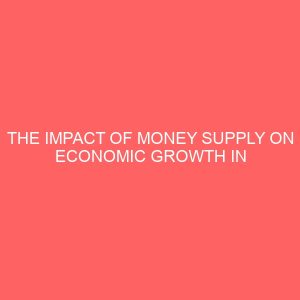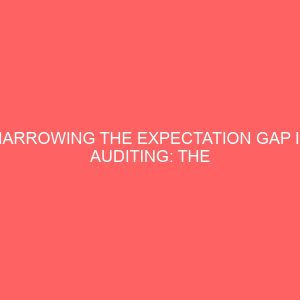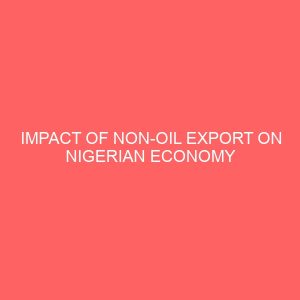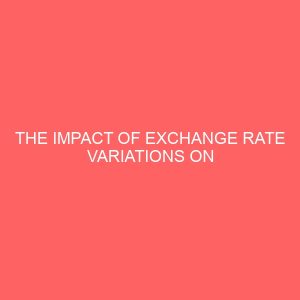Description
INTRODUCTION
1.1 BACKGROUND OF THE STUDY
In the critical observation of the recent Nigerian economic position, there has been a great divergence between the rate at which money is supplied and the exact impact it has on the general price level, which results in inflation and deflation on one hand, and the output growth productivity on the other hand. Although, it had occurred to our mind that Nigerian monetary policy continues to aim at achieving single digit inflation, a stable Naira, increase in domestic production and a stock of foreign exchange reserves equivalent of at least six months of current imports, the Central Bank of Nigeria CBN relies on Open Market Operation OMO, Cash Reserve Operations, Minimum Liquidity Ratio, Discount Window Operations OWO etc, to control growth in monetary aggregates, changes in minimum rediscount rate MRR to determine interest rates, and a Dutch Unction system to determine the value of the Naira See Anyanwu, 2003.
However, the CBN publications have proved that since 2003, the monetary authority is conducting an Open Market Operation on a daily basis instead of biweekly in order to exert greater control over the countrys Nigeria financial market conditions. Hitherto, monetary aggregates have tended to overshoot the CBNs targets due largely to the expansionary fiscal policies. Then, as a result of this fiscal surplus, in the first nine months of 2004, annualized growth in broad money supply M2 was only 13.2 compared with the expansion of 24 made in 2003 See CBN Annual Report and Statement of Accounts, 2003.
In the year 2004, the Federal Government strengthened the budget process towards an improved expenditure coordination through the introduction of Cash Management Committee CMC, whose function was to monitor and reconcile monthly expenditure releases, and determined projects. But in that same 2004, the annual inflation rate was moderated to an estimated 15.0 in October 2004. The persistence pressure on prices in 2004 was attributable to the impact of the partial deregulation of the 2003 monetary expansion. Since the face of the interest rates remain largely stable in 2004, it was expected that inflation will follow a downward trend in 2005, 2006 and 2007, as the continued improvement in Agricultural production reduced inflation in food prices, Source, CBN Annual Report and Statement of Account, 2003.
Furthermore, from the recent CBN Annual Statement of Reports under the real sector, it was indicated that the growth in domestic Product GDP measured in 2007 in 1990 basic prices amounted to N634.1 billion thus, representing a growth rate of 6.2 compared with 6.0 in 2006. However, output growth fell below the projected average of 7.0, estimated for the five year period 20032007. Growth in 2007 was broad based but driven mainly by the nonoil sector. Agriculture grew by 7.4 led by crop production and fishing. Wholesale and retail trade grew by 15.3 and services subsector by 9.8. Mining and quarrying as well as manufacturing however, grew even as electricity consumption declined. The moderation in inflationary pressure that began in 2005 was sustained in 2007, attributable largely to good Agricultural harvest and a nonaccommodating monetary policy. Thus, the single digit inflation target had been sustained two years in a row. Further expansion in national output was however, constrained by poor infrastructures, a mild drought and flooding experienced in some food producing areas.
Available data from the National Bureau of Statistics NBS, indicated that the national unemployment rate in the 1st quarter of 2007 was 14.6, compared with 13.7 in 2006. The Urban and Rural rates were 14.4 and 15.0 respectively compared with 10.2 and 14.8 in 2006.
Meanwhile, the reason behind the monetary trends above, is to understand the lapses in monetary management, and having observed the alternations between the rate of inflation and deflation, it seems as if we had not done enough work, in regulating the supply of money. Otherwise, we had found the repeated cases in which people seem to have so little money that they were unable or certainly reluctant to buy everything that could be produced. As a result, price fell, profits vanished, production shrank and unemployment spread.
We had also found frequent examples of the opposite situation, where the inflation spiral in which the quality of money outruns the supply of goods and people would lose through being outbid in the market place.
The whole mystery is centered on the fact that commercial bank credit is a major factor contributing to the increased quantity of money in circulation in the Nigerian economy. But since the total stock of money determines the economy level to an optional, the monetary policy target is to bring the economy back to a desired optimum, but the extent to which it achieves that, is however another issue. The popular notion is that most monetary policies had failed in Nigeria due to wrong implementation of the policies or due to the uncooperative attitude of the banks before the consolidation of banks in Nigerian economy in January, 2001.
Therefore, in discussing the concept of money supply and its impacts, two other issues often come to our mind namely, the state of inflationary pressure and the unemployment rate. According to the monetarist inflation is everywhere a monetary phenomenon. Their view was that increase in money supply in an economy, causes an increase in the general price level of commodities inflation Uzoaga, 1981.
Related to the problem of inflation is the issue of unemployment. Generally, the primary goal of any economy is to achieve a high level of employment so as to be able to produce as many goods and services as possible while maintaining an acceptable level of price stability. Therefore, the level of output or productivity real GDP and employment on one hand, and the level of prices on the other hand, has a common determinant which is the level of total spending.
Thus, we have so far been observing that the control of money supply could control all the variables that are obstructed from its targets, such that gross domestic product, employment, aggregate demand etc, could be controlled in Nigeria simply by controlling the money supply. This research work therefore, would review the technicalities involved in the control of money supply in Nigeria economy.
1.2 STATEMENT OF PROBLEM
A study of this nature is always necessitated by the existence of certain problems. The major problem that triggered off this work is the reoccurrence of general price instability and persistent inflationary pressures in the economy, in spite of the plethora of monetary policy tools adopted and applied over the years.
There is also this problem of general feeling that a continuous annual rate of money increase will adversely increase the rate of price level which will directly lead to inflation, thus, requiring a policy response. Recently, this inflationary pressures had succeeded in erecting a devaluation in Nigeria’s currency value as a result of expansionary measures of money supply.
From the above problems, this research work is meant to investigate on these questions viz;
a. Why has the expansionary and contractionary measures of money supply adopted by the CBN failed to correct the problems of high rate of inflation and real Gross Domestic Growth GDP in Nigerian economy
b. Are the monetary policy measures adequate in controlling the rate of economic depression in Nigerian economy
c. If measures been adopted were ineffective and inefficient, what should be the rightful measures to be taken in order to promote real GDP Growth in Nigerian Economy
TABLE OF CONTENT
Title Page
Approval Page
Dedication
Acknowledgement ..
Table of Content
Abstract
CHAPTER ONE: INTRODUCTION
1.1 Background of the Study.. 1
1.2 Statement of Problem . 7
1.3 Objectives of Study . 14
1.4 Research Hypothesis . 14
1.5 Significance of the Study. 15
1.6 Sources of Data and Its Scope .. 16
CHAPTER TWO: REVIEW OF LITERATURE
2.1 Theoretical Literature 17
2.2 Empirical Literature .. 22
2.3 Meaning of Monetary Policy . 28
2.4 Objectives of Monetary Policy 29
2.5 Monetary Policy Formulation in Nigeria . 30
2.6 Determinants of Money Supply in Nigeria 31
2.7 Nigeria Financial Institutions .. 35
2.8 Objectives of Nigerian Financial . 36
2.9 Significant Developments in the Nigerian financial Institution in recent times 38
2:10The Impacts of Money Supply in Nigeria Economy 39
2.11Control of Money Supply in Nigeria 42
CHAPTER THREE: RESEARCH METHODOLOGY
3.0 Introduction .. 45
3.1 Institutional Consideration . 45
3.2 Estimation Procedure .. 46
3.3 Model Specification .. 47
3.4 Method of Evaluation .. 48
3.5 Decision Rule .. 50
3.6 Data Required and Sources. 51
CHAPTER FOUR
4.0 Presentation and Analysis of Result 53
4.1 Presentations of Results .. 53
4.2 Analysis Based on Statistical Criteria 1st Order Test .. 56
4.3 Econometric Test or 2nd Order Test .. 59
CHAPTER FIVE
5.0 SUMMARY, CONCLUSION AND POLICY RECOMMENDATION
5.1 Summary .. 61
5.2 Conclusion .. 62
5.3 Policy Recommendation .. 63 Bibliography
Appendix








Reviews
There are no reviews yet.